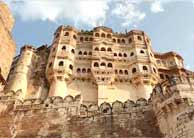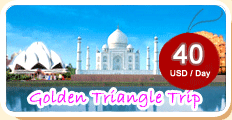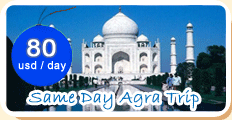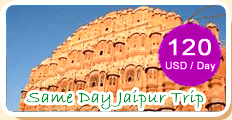
Jodhpur Tour

 This bustling desert city is the second largest city in Rajasthan after Jaipur and has landscape dominated by the massive Meherangarh Fort topping a sheer rocky ridge.
This bustling desert city is the second largest city in Rajasthan after Jaipur and has landscape dominated by the massive Meherangarh Fort topping a sheer rocky ridge.The old city is fenced by 10 km long wall with eight Gates leading out of it. The new city is outside the walled city. Rao Jodha, a chief of the Rathore clan, founded the city in 1459 and it is named after him.
The Afghans drove the Rathores out of their original homeland Kaunaj and they fled to this region around Pali a short distance from present day Jodhpur. A manoeuvre lead to marriage between Rathore Siahaji and the sister of a local prince that helped the Rathores to establish and strengthen themselves in this region. In fact they flourished so well that managed to oust the Pratiharas of Mandore, just 9 km of present day Jodhpur. By 1459 a need for more secured capital lead to the founding of Meherangarh
Fort on its rocky perch and Jodhpur was thus founded by Rao Jodha. The Rathores enjoyed good relations with the Mughals and Maharaja Jaswant Singh (1678) supported Shah Jahan in the latter's struggle for war of succession. Only problematic relationship they had was with Aurangzeb. After Auranzeb's death Maharaja Ajit Singh drove out Mughals from Ajmer and added it to Marwar.
THE MEHRANGARH FORT
Earlier called the Chintamani fort, the fort was built in 1459 by Rao Jodha the founder of Jodhpur on the summit of a steep hill called the Bakharchiriya or bird's nest. The citadel was fortified by eight Pols or gates (now reduced to seven) regulating entry into the premises. The expansive ramparts of the castle span some 10km, and if you stand atop the fort, you do get a bird's eye view of the city with its whitewashed homes. Bakharchiriya was an apt name for the hilltop on which the fort now sits, is perched on top of Meherangarh and from there you get a commanding view of the landscape. In fact from that vantage point, you can even sight the Kumbhalgarh fort situated a good 125 km away. The fort stands 122 metres above the plain and rises on sheer bare rock. It is fortified by walls ranging from seven to twenty-four metres in thickness, and rising upto a height of 40 metres.
THE JASWANT THADA
The Jaswant Thada, located half way up the interminably long road that climbs onwards to the fort, is the traditional cremation ground of the rulers of Jodhpur. Taking pride of place amongst the ornamental gardens and chattris is the fabulous white marble memorial to Jaswant Singh II, built in 1899. The cenotaphs of other rulers , in the same neighborhood , are relatively simpler.
THE UMAID BHAWAN PALACE
If there is one palace that combines architectural extravaganza with aesthetic triumph, it is the Umaid Bhawan Palace. If there is something that is best experienced than described, it is absolutely a stay at the Hotel Umaid Bhawan Palace.
Furnished with fashionable Art Deco interiors by the Polish artist and decorator, S. Norblin, the Umaid Bhawan Palace consumed one million square feet of the finest marble. The world of Hotel Umaid Bhawan Palace, Jodhpur contained everything that the royalty required – a private cinema hall, a luxurious swimming pool inlaid with tiles depicting the zodiac, gigantic royal suites, a soaring rotunda, fancy ball rooms, a majestic durbar hall, billiards room, ballrooms, banquet halls, libraries, staff quarters, servant quarters.
THE RAI KA BAAG PALACE
The Rai Ka Bag Palace of Jodhpur, Rajasthan is a well known tourist spot to visit. This palace was built in 1663 by the queen of Maharaja Jaswant Singh-I, Hadiji. It is located right next to the Raika Bag palace railway station. In 1883, When Swami Dayanand Saraswati visited Jodhpur, he preached from this palace.
MANDORE GARDEN
Mandore garden is a popular local attraction. In the Mandore garden, there are the dewals or cenotaphs of Jodhpur's former rulers. Mandore garden has high rock terrace. The garden is open for tourists from 8 am to 8 pm. The ruined fort and palace of yester years are still intact on the hilltop and below this there is Mandore garden for public amusement and has the cenotaphs of Jodhpur's maharajas probably using this garden. Besides a baoli, there is the Hall of Heroes, with 15 figures carved out of living rock, from where the path to the fort reaches Mandore Gardens.
NEHRU PARK
The city of Jodhpur, although situated in the desert city of Rajasthan, has some wonderfully landscaped gardens to boast of. The gardens in Jodhpur are considered to be major tourist attractions in Jodhpur. One of the best ways to connect with nature is through parks and gardens. They are a visual treat to the eyes of the tourists, acting as a break from the desert landscape. During tours to Jodhpur you should visit the various parks in Jodhpur, India. There are quite a few gorgeous Jodhpur gardens for the purpose of sightseeing. Among them Nehru park, Jodhpur warrants a special mention.
UMED GARDEN
One of the popular gardens of Jodhpur is the Jodhpur Umed garden. It is spread on an area of 82 acres. The famous Umed garden of Jodhpur, Rajasthan was developed by Maharaja Umed Singh. It is named after him only. The garden has five separate gates around it to facilitate entry to the garden from different directions. It has lush green lawns with beautiful roses and other seasoned flowers. Also inside the garden, is a museum, towering Ashoka trees, artistically designed fountains, a library and a zoo.
GOVERNMENT MUSEUM
Government Museum in Jodhpur is situated on High Court Road. This museum is very famous tourists for featuring wide collections. Constructed during the rule of Maharaja Umed Singhji, this museum displays rich assortment of weapons, textiles, miniature portraits, local crafts and images of Jain Tirthankars. It boasts of stuffed animals of which several desert birds kept in glass cases with thorn bush capture immense attention. This apart, in this museum a military section has also been introduced which holds wooden biplane models and a wonderful brass battleship.
CLOCK TOWER AND SADAR MARKET
In the old city, clock tower is a prominent land mark. But main attraction is the Sadar Market. The market has kept alive the old 'haat bazaar' culture. Sadar market is a lively, bustling, colourful market which runs from Sojati Gate to the Clock tower (which is late 19th century). In the distance you can see the vast bulk of the Meherangarh Fort which dominates the skyline for miles around.
JHANKI MAHAL
The Jhanki Mahal, from where the royal ladies watched the official proceedings, in the courtyard, today houses a rich collection of the royal cradles. The cradles are decorated with gilt mirrors and figures of fairies, elephant and birds.
OSSIAN
65 Kms from Jodhpur, lies ruins of an ancient city called Ossian. This city is famous for Brahmanical and Jain temples, which belong to 8th and 11th century. Surya or Sun temple and the Sachiya temples are famous for their beauty. The shikhar of Sachiya temple is clustered by two rows of turrets, an ambulatory and a large assembly hall with an elaborate ceiling. This town which was once a great trading centre is an oasis and houses an abundance of peacocks. The largest of the 16 Jain and Brahmanical temples is dedicated to Mahavira, the last of the Jain tirthankars. In the same area the Surya temple has fascinating images of Durga, Surya and Ganesh. The sculptural intricacy of the Osian temples rival that of any of the famous temples of the country, be it the Sun Temple of Konark, or the Hoysala temples of Karnataka.
PHOOL MAHAL
Phool Mahal (means 'the palace of flowers') is now the most popular period room in Mehrangarh Fort Museum. It was built by Maharaja Abhaya Singh in the eighteenth century as a private room for the king's pleasure. The gold used for the construction of Phool Mahal is believed to have come from Gujarat as the booty of the war in which the king defeated a Mogul governor.
BALSAMAND LAKE AND PALACE
Balsammand Palace in Mandore, Rajasthan offers you this kind of comfort. This palace is built on a hillock facing Balsammand Lake. This popular excursion of Jodhpur, Rajasthan was constructed in 19th century and is made up of sandstone.
Maharajah Sur Singh of Jodhpur, as a summer pavilion, built this palace encircled by hills. The Balsammand Palace of Jodhpur, Rajasthan is beautifully carved. Allowing the cool breeze to blow into the palace are the latticed windows. The lakeside, in front of the palace, has domed structure that provides fabulous views of the lake. The gardens get water from an artificial waterfall, bringing down water from the reservoir.
GUDA BISHNOI
Discover a world of tribal color and rustic cultural grandeur on your tours to the Guda Bishnoi Village located at a distance of 25-kilometers from the main Jodhpur city.
Picnic near the tiny manmade lake located in the Guda Bishnoi Village and see migratory birds stop here and drink water. Photograph herds of deer that stop and gaze at you with vulnerable eyes and marvel at the floral variety that flourishes in a supposedly barren land
JASWANT SAGAR DAM
The Jodhpur Jaswant Sagar Dam lies in Pichiyak village between Bilara and Bhavi of Jodhpur district. It was constructed, in 1892, by Maharaja Jaswant Singh. The water from Jaswant Sagar Dam of Jodhpur, Rajasthan is utilized for irrigation purposes in Jodhpur. The greenest part of Jodhpur receives water from this dam. Also available here, are boating facilities have for tourists. It is nice place for those who love boating or wading around in water. Also, a visit to the Jaswant Sagar Dam will serve as an educational trip for the children.
MACHIYA SAFARI PARK
Machiya safari park is a must watch site near Jodhpur. The rustic wilderness of the park will certainly steal your heart when you visit this place. The park also houses a fort inside its complex. The fort offers a wonderful view of the sunset. You can also take up an elephant ride for a bird's eye view of the scenic wildlife park. Explore the fauna and fauna of the mesmerising park while riding on the elephant. So in a nutshell, we can say that Machiya Safari Park is an interesting place, and you should not miss on it if you are on a trip to Jodhpur.
PALI CITY
Pali city is situated 70 kms from the Jodhpur. NH 14 links Pali from Delhi in North and Ahmedabad in South. Pali City has two very old temples namely Somnath and Naulakha. Somnath temple is devoted to Lord Shiva and known for its handsome bulling having exquisite moldings. Naulakha is a Jain temple having elaborate carvings.
























